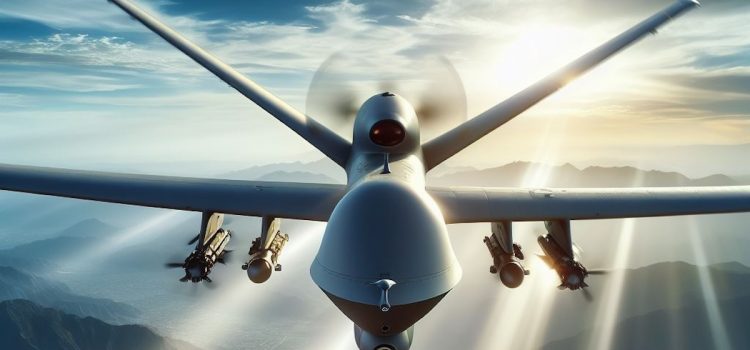

This article is an excerpt from the Shortform guide to "The Daily". Shortform has the world's best summaries and analyses of books, podcasts, and more.
Like this article? Sign up for a free trial here.
How do drone strikes reshape defense strategies? What unseen psychological tolls do drones inflict? How has the use of drones in combat evolved?
An episode of The Daily podcast explored the impactful role of drones in modern warfare through Ukraine’s strategic drone strikes against Russian military targets and infrastructure. These precision attacks have reshaped defense strategies, while also influencing psychological dynamics in the conflict.
Read more for a summary of the episode, along with some vital context and considerations.
Drones in Combat
Ukraine’s drone strikes have proven highly effective by targeting Russian military aircraft and disrupting critical infrastructure, notably oil storage facilities. These precise hits have compelled Russia to reassess its defense strategies, strategically weakening its military presence in the conflict.
Also, the use of drones in combat is inflicting unseen psychological tolls on Russian civilians and key political figures, potentially eroding trust in Putin’s leadership.
Although the development of tactical drone strikes faced initial challenges such as drones crashing into trees, it showcases a process of continuous technological improvement.
Despite obstacles, there has been a notable increase in both the frequency and success of drone attacks, underscoring Ukraine’s advancing operational capabilities.
The unsettling sound of the drones has emerged as a psychological warfare tactic, instilling fear well before the strikes’ physical impact.
While the full impact of the drones on Russian morale and infrastructure requires further assessment, their psychological influence, notably the intimidating drone noise, is a crucial element of Ukraine’s strategic offensive.
Context
Drones have become a significant component of modern warfare, especially in the Ukraine-Russia conflict. These unmanned aerial vehicles, operated remotely or autonomously, play a crucial role in military operations. They’re equipped with various tools such as cameras, sensors, and weapons, proving effective in targeted strikes. But, their use raises ethical issues regarding civilian casualties and targeted killings.
In the context of the conflict that began in 2014 with Russia’s annexation of Crimea, both Ukraine and Russia have employed diverse military strategies. Drone technology has evolved from initial challenges to more frequent and successful strikes, showcasing the changing nature of warfare and the increased reliance on unmanned systems for reconnaissance and offensive actions.
Psychological warfare is another significant aspect related to drones in combat. Beyond their physical capabilities, drones are used to instill fear and disrupt enemy morale through tactics such as propaganda or intimidation, making them a potent tool on the battlefield.
Future developments could include technological advancements in drone capabilities and greater integration of artificial intelligence into autonomous systems. Potential regulations or international agreements might also be implemented to address ethical concerns about civilian casualties and targeted killings in drone warfare.
While this explanation primarily focuses on the Ukraine-Russia conflict from an external perspective, exploring alternative viewpoints, such as Russia’s response to drone strikes, can offer more insights into their military strategy and morale.
Overall, drones are rapidly evolving military technology with significant implications for modern warfare. As conflicts persist globally, it’s essential to consider their tactical advantages while addressing ethical dilemmas surrounding their use.
More Perspectives
As discussions continue on the advancements and implications of drones in combat, it’s vital to critically examine claims about their effectiveness. While drone strikes are said to have successfully targeted Russian military aircraft and disrupted key infrastructure, comprehensive data and analysis are essential to accurately assess their true impact. Without such information, it’s challenging to determine if these claims are exaggerated or based on incomplete evidence.
Attributing Russia’s defense positioning solely to the effectiveness of drone strikes might oversimplify a complex geopolitical situation. Considering other influencing factors such as political, economic, or diplomatic considerations is crucial for a nuanced understanding of the role of drone strikes in shaping military influence.
Claims about drones imposing unseen psychological costs on Russian civilians and key political figures need further substantiation. Without specific examples or studies demonstrating the psychological impact, it’s hard to evaluate the validity of this assertion. It’s important not to overlook other factors contributing to psychological states during conflict.
While technological refinement is inherent in advancements, stating that tactical drone strikes have undergone an iterative process doesn’t inherently prove their effectiveness. The absence of concrete data or evidence supporting claims about a significant increase in frequency and effectiveness raises questions about the validity of such statements.
Related Reading
Biden can reduce civilian casualties during US drone strikes
A recent report based on Pentagon documents reveals an acceptance of collateral damage in US strikes, resulting in civilian casualties. US President Joe Biden’s “over the horizon” counterterrorism strategy relies on armed drones, but fails to address civilian casualties.
Combat drones: We are in a new era of warfare – here’s why
The use of combat drones is no longer limited to military superpowers and is changing the nature of warfare. The MQ-1 Predator and its successor, the Reaper, have become iconic weapons in counter-insurgency warfare.
Psychological Dimensions of Drone Warfare | SpringerLink
The psychological impact on drone operators—including stress, burnout, and symptoms of post-traumatic stress disorder—is examined. The civilian harm and trauma caused by drone practices in Pakistan and Yemen are highlighted.
How Drones May Reshape the Economy, If They’re Allowed To
The global drone market is expanding rapidly and is expected to reach $56 billion by 2030. But, strict FAA regulations on drone flights are limiting further growth of commercial drone services.

———End of Preview———
Like what you just read? Read the rest of the world's best guides to The Daily" at Shortform.
Here's what you'll find in our full The Daily episode summaries:
- Key insights from the daily podcast from the New York Times
- Key topics that came up during interviews with the paper’s journalists
- Some of the main news stories from the day that you need to know






